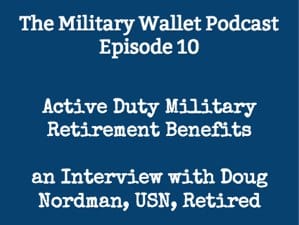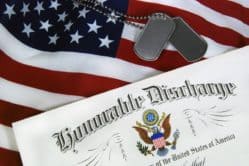Table of Contents
Today’s podcast covers active duty military retirement benefits. We cover a wide range of topics in this interview with Doug Nordman, military retiree and author of The Military Guide to Financial Independence and Retirement.

As a military retiree, Doug has a great perspective on what it takes to earn an active duty retirement, as well as how to maximize the benefits you are eligible to receive as a military retiree.
In our interview, and in this guide, you will learn more about:
- How to qualify for an active duty retirement
- How to calculate an active duty pension
- How to prepare to live on your military pension
- The power of Cost of Living Adjustments (this is much more valuable than you think!)
- Health care options through TRICARE
- Base access, shopping, & activities
- and other valuable retirement benefits.
About Doug Nordman: Doug is a retired Navy officer and the author of The Military Guide to Financial Independence and Retirement. This book had a large impact on me and I highly recommend it. Doug also founded a website called The Military Guide where he writes about a variety of topics related to military benefits, veterans topics, retirement, personal finance, and financial independence.
The following article covers many of the facts in the podcast but, due to space limitations, it leaves out some of the examples and additional information found in the podcast.
I recommend listening to the podcast if you have the time, and bookmarking this as a resource for future reference.
Military Guide to Financial Independence
This book provides servicemembers, veterans, and their families with a critical roadmap for becoming financially independent. Topics include:
- Military pension
- TSP
- Tricare Health System
- & More
How to Qualify for Active Duty Retirement
In the past, you needed to serve 20 years to be eligible for military retirement benefits. With the implementation of the Blended Retirement System (BRS), which went into effect on January 1, 2018, servicemembers have more options. If you enter the Uniformed Services on or after Jan. 1, 2018, you are automatically enrolled in the BRS. This is your only retirement plan option. For those who were in the service prior to Jan 1, 2018, eligibility will depend upon your time in service. The benefit of BRS is you get a portion of retirement even if you don’t hit the 20-year mark. The Thrift Savings Plan serves as a civilian 401K, where you receive retirement payments based on the time in service and are fully vested once you hit 20 years.
For those who retire prior to the 15-year mark, you may qualify for TERA under the Temporary Early Retirement Authority.
Active Duty Retirement Pensions
There are 4 Main Types of Military Retirement Pay Plans:
- Final Pay / High Pay – for servicemembers who entered the military before Sep. 8, 1980
- High 3 – for servicemembers who entered the military after Sep. 8, 1980
- REDUX – an elective retirement option for servicemembers who entered the military after Sep. 8, 1980
- Blended Retirement System (BRS) – went into effect on January 1, 2018 for servicemembers who joined on or after that date. Members who had 12 or fewer years of service at that date were eligible to opt into the BRS. Here is a full overview of the Blended Retirement System.
This podcast focuses almost exclusively on the High 3 Retirement Plan because it was recorded prior to the announcement of the BRS. At the time of the recording, most current servicemembers and recent retirees were eligible for the High 3 Retirement Plan. REDUX is not discussed other than to say it is not a great option.
Military Pensions Are from Your Base Pay Only
Your first retirement paycheck may surprise you. In fact, you might think there is an error. That’s probably because many people think their retirement pay will be roughly half their normal military paycheck. Unfortunately, that isn’t the case. The Blended Retirement System uses a 2.0% multiplier for each year of service instead of a 2.5% multiplier, making a 20-year pension worth 40% of the retirement pay multiplier instead of 50%. 25 years would be 50%, 30 years would be 60%, etc.
Rules of Thumb for Calculating Your Retirement Pay (High-3 Retirement System): Doug gave us a couple of rules of thumb to use for some back of the envelope calculations to get a rough idea of what your retirement paycheck will look like.
- 95% Rule of Thumb: To calculate your pension under High-3, you can multiply your final base pay by 95% (this accounts for the annual raises during your final 3 years). Then multiply this by your multiplier based on years served (2.5% per year served under High-3; this comes out to 50% at 20 years). So at 20 years of service, your pension would be roughly 47.5% of your final base pay (50% * 95% = 47.5%).
- 30% Rule of Thumb: Another rule of thumb is to look at your total compensation (base pay, BAH, and BAS) and multiply that by 30%. That will get you in the ballpark of your pension payment. Note: this is less precise than the 95% rule of thumb, and may vary by rank and your location if you have a high BAH.
Get a More Precise Estimate of Your Pension:
Every service has an online retirement calculator that allows you to put in very granular information, including your Date of Initial Entry Into Military Service (DIEMS), your estimated retirement date, and other factors. It’s important to note that these calculators are often password protected and you need to login to your branch website to get this information.
Notes on Military Pension Payments:
- You will not receive your first pension payment until the month after you retire.
- Checks only arrive once a month at the beginning of the month (may arrive a day or two early, depending on your bank – some military banks will actually deposit military paychecks and pensions early).
COLA Adjustments
The most underrated part of military pensions is the Cost of Living Adjustments (COLA). Military pensions are tied to an annual COLA based on the Consumer Price Index, or the average cost of inflation over a variety of consumer goods. This varies from year to year. In some years there is no COLA increase to retirement pay, and in other years it could 1%, 2%, or even higher.
What makes COLAs so valuable is they work like compound interest—they stack on top of each other. So your first COLA may be small, but it increases your base for the next COLA. Over time, even small gains of 1%-2% can make a huge difference. For example, Doug shared that his military pension has increased by 27% over the last 12 years, just from COLA increases. 27% is huge!
It would not unreasonable to see a pension double in one’s lifetime, depending on various factors such as when the veteran retired, how long the retiree lives, etc.
Big note: As Doug points out, the 27% pension increase is great. But it’s also just enough to keep up with inflation. So while the overall dollar amount is larger, the purchasing power should remain roughly the same. But what many military retirees don’t realize is that many private-sector pensions aren’t indexed to inflation. That makes the Cost of Living Adjustment an immensely valuable benefit.
Health Care in Retirement
Because this podcast was recorded in 2014 the details below may no longer be accurate. For up-to-date Tricare information please see our summary articles highlighting Tricare Prime, Select, and Tricare for Life.
Military retirees are eligible for health care coverage through TRICARE. You will start off with TRICARE Prime or Standard if you are under age 65. TRICARE Prime is the same health care coverage you have as an active duty member. However, it is only eligible if you live within a certain distance of a military installation. If you move out of the area, you would only be eligible to use TRICARE Standard. TRICARE Prime and Standard both have monthly premiums and certain associated copays.
If you are age 65 or over, you would be eligible to receive TRICARE for Life, which is a Medicare Supplemental Insurance Program. There are no monthly premiums for this plan.
Which Tricare plan is the best for Retirees?
This is where it’s a good idea to listen to the podcast episode. Doug goes into each of these plans in more detail and explains the associated pros and cons of each plan. Additionally, you can contact a TRICARE Ombudsman who can help you decide which plan is best for your situation. There should be one at each Military Treatment Facility, or you can contact TRICARE, and they will have someone explain things to you and help you choose.
Here are some plan details, and links to the website:
TRICARE Prime – Premiums ($50/ mo for member & dependent):
- $12 copay off-base
- MTF – space available, but no Copay
- Prescriptions
- Formulary – free
- Local pharmacy – variable
- Only available until age
- Only available within 40 miles or 30 minutes from a military base (cost-cutting measure) There are waivers for this.
- Link to TRICARE Prime website.
TRICARE Standard:
- No premiums
- Only pay when you visit a doctor
- Only pay 20-25% of the negotiated rate
- Only pay for the treatment you receive
- Link to TRICARE Standard website.
TRICARE for Life age 65:
- Retirees go on Medicare
- Medicare Supplemental Insurance
- No premiums for TRICARE for Life
- Link to TRICARE for Life website.
Additional Health Care Info Covered in the Podcast:
- Healthcare for dependents
- What if you don’t live near a Military Health Care Facility?
Does all of this sound a little confusing? It certainly can be. Thankfully, each Military Treatment Facility has a TRICARE ombudsman who can help you make sense of your options and help you make the best decision based on your needs.
Military Retiree Dental Care
Military retiree dental coverage was provided through the TRICARE Retiree Dental Program (TRDP) until November of 2018. At that point, the TRDP transitioned to the Federal Employees Dental and Vision Insurance Program (FEDVIP).
Military retirees have the option of using the FEDVIP program for their dental insurance. Other options include purchasing coverage through a civilian employer or self-insuring for dental care.
This article covers military retiree dental care options in more detail.
Other Retirement Benefits
Doug and I discuss other military retiree benefits, including access to base facilities such as the:
- Commissary
- Base Exchanges
- Gyms
- Hobby activities where available, such as the Auto Hobby Shop, Woodworking Shop, MWR facilities, movie theater, etc.
These base activities can be a great way to save money, participate in hobbies, and continue to be a part of the military community.
Military Hops – Space-A Travel
Military hops and Space-A travel are other topics we discussed. These can be a great way to see the world on the cheap. Basically, flying Space-A allows you to jump onto a military transport if there are available seats. You pay a nominal fee (usually only a few dollars). You can often find trips going all over the world, and many of the flights go out on a regular basis.
There are some downsides, however. Because you are flying on a space-available basis, you may not be able to get the flight on the day or time you want. Flexibility is the key if you use Space-A travel!
Benefits for Spouses & Dependents
Benefits for your dependents, including your spouse and children, are similar going to be similar to when you were on active duty, with the exception of your health care which will depend upon your specific situation (whether you are eligible to use TRICARE Prime, or are required to use Standard). Spouses and dependents still maintain base access and access to the Commissary, Exchanges, MWR facilities, and other base activities.
Did we miss anything? Military retirement is a huge topic, and we tried to cover as much as we could in the 40 minutes or so that we talked. I also did my best to get the main points down on paper for those who prefer to read. Please leave a note in the comments if we missed anything and we’ll address it. Thanks!




Comments:
About the comments on this site:
These responses are not provided or commissioned by the bank advertiser. Responses have not been reviewed, approved or otherwise endorsed by the bank advertiser. It is not the bank advertiser’s responsibility to ensure all posts and/or questions are answered.
Demario Bolden says
How do you get 20,000 dollar pension if someone made a average of 100,000 a year for their last three years?? That’s now 40 percent of pay at 20 year??? It should be 40,000
Jerry Stone says
I’m a healthy 24 year veteran of the Navy. I moved to a part of the state where there is no military base. I have SS and my veteran pay. Everything else I pay for, health, dental vision out of my retired pay. Why do I feel like after serving 24 years and then working another 20 years at the Corps of Engineers that I have less benefits than someone who has served 4 years claimed PTSD and gets a better pay check with more benefits than me. Someone please explain that to me. My pay raises are tied to COLA so some years I get no raise while the price of everything goes up. Am I missing something? It makes me want to fake PTSD or some other thing so that I can feel equal.
Retired Navy Chief
Demario Bolden says
There is no way you should not have a good retirement. You should have more than the PTSD veteran
John Rowan says
What about APO mail service while working overseas.
John Robert Stehwein says
I’m trying to get the retirement pkg paperwork, I called the base and no one knew anything about it. I need to file for my retirement pkg. how can I get the paperwork I need?
Ryan Guina says
Hello John, I don’t know the exact process. I believe you will need to work this through your Personnel or Human Resources office. Someone on that office should know how to start the process.
Aaron says
Great podcast! Thanks for all the information.
Mike says
Would it be possible for you to explain all the different ways you can earn an “active duty” retirement while serving in the IRR, IMA, Guard, Reserve, etc. I understand I can use my active duty years to count as “Good Years” for a reserve retirement that would start paying me at 60. And I have heard differing stories about attaining an “Active Duty” retirement that would start paying me immediately. It sounds like I need 7200 (or 7300) of active points to make that happen. Obviously all inactive time would not count (drill weekends, yearly drill 2 weeks, etc.) Does all AGR time count? Active Duty Orders count, correct? Would all IMA time count towards active points? How about the 15 points for being on IR? PIRR, Civil Air Patrol, ALO, Honor Guard? I’d like to leave active duty at 18 years, but I don’t want to wait until 60 to collect a retirement… even if I have to work a few years more to get the points. Thanks!
J WIlly says
Why dont you go see your Career Counselor.
Wayne says
Please add that when retired service members turn 65 and are on a fixed retirement income and are required to go on Medicare as part of Tricare for Life, the annual premium goes up almost 400 percent. I’m single and I will see my annual premium at age 65 change from just under $300 to a whopping $1300 per year. I’d estimate married couples go from just under $600 to arid $2600 per year. Talk about your financial planning!!!